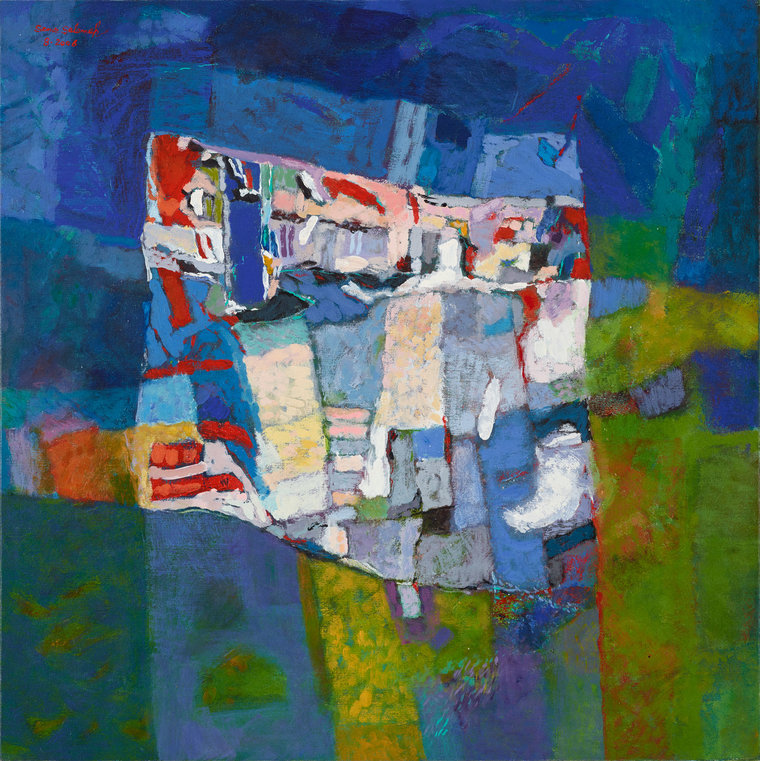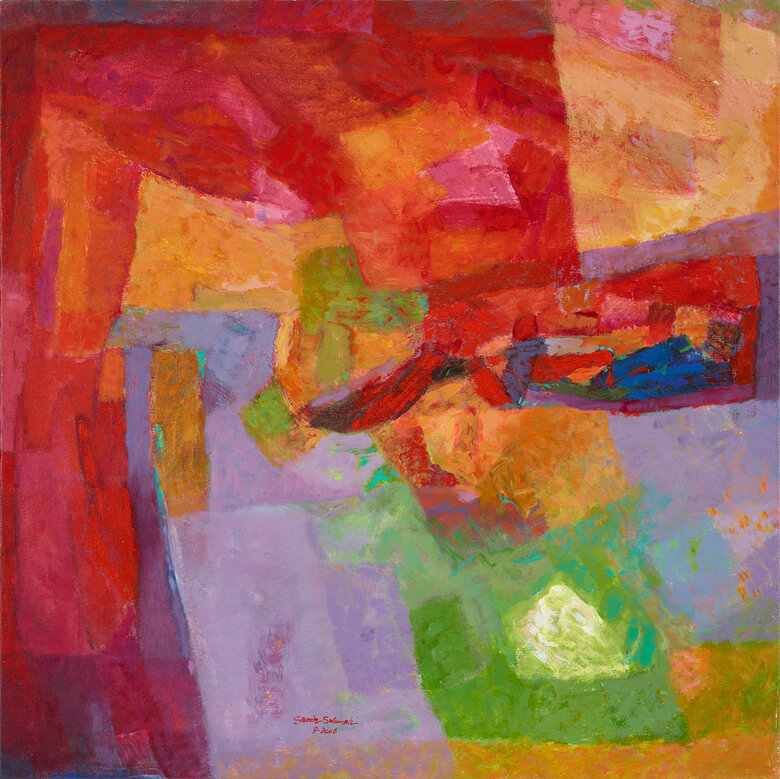‘Untitled,' 2006, 75x75cm, created by Palestinian artist Samir Salameh, is an abstract acrylic on canvas painting depicting an array of square and rectangular shapes, mostly in shades of green and blue. In the middle register of the picture are masses of paint in tones of red, blue, and white within an off-kilter quadrilateral shape. Rather than appearing static or fixed, the hues of blue in the upper half of the painting are executed in a spontaneous, gestural style that suggests fluidity and accentuates the composition's vibrant energy. The planes surrounding the middle register give a sense of flatness; however, the lighter colors at the center suggest staggered shapes at different levels. Including colors such as yellow and green, primarily found in nature, particularly in the lower right corner, adds a hint of a natural environment, alluding to a landscape, with the sheen of orange and diluted red implying a blossoming spring.
Salameh challenges our perception of space and perspective, offering a unique vantage point to engage with the themes of this artwork. The painting evokes the layered land terraces, often used for agricultural purposes across the Mediterranean, particularly the hilly areas of Palestine, that Salameh used for inspiration at various times in his work. The shades of white scattered in different rectangular formations at the center ask us to imagine the stone houses scattered across the hills of Bethlehem, the façades of which are accentuated through his staccato[1](short and broken) brush strokes using touches of pink, rose, and yellow. Next to the long blue swath in the upper right corner of the quadrilateral are several vertical strokes, each in pairs of purple, turquoise, or light blue, alluding to the long windows often found in the architecture of traditional houses in Palestine. Similarly, in the lower-left corner of the quadrilateral, the two parallel strips of red with lighter brush strokes at their center are an abstraction of the large verandas with their familiar arches and the shadows or light coming through them. All of these abstracted elements – the stone houses, their red brick, their spacious verandas with their iconic arches, the terraces of land stacked on each other – coalesce to reflect Salameh’s yearning and nostalgia for his Palestine.
Employing an abstract style, Salameh is able to manifest the distance and detachment he experienced when forced to leave his homeland. Witnessing the 1948 Nakba, he fled to Syria as a child and, years later, in 1996, returned to Safed to find his old family home; however, his efforts were met with disappointment.[2]. For Salameh, art is reflection, a medium to explore his complex experiences and express the nuances of the Palestinian struggle. His work captures the emotional depth of these historical and ongoing challenges without burdening his audience.[3]. His canvas becomes a playground for recollection, a space where memory and figments of imagination blend to reconstruct a longed-for past. In this hopeful endeavor, the depicted house and landscape materialize as fragments of a remembered homeland, demonstrating art's power to negotiate the spaces between memory and reality, past and present. His abstract forms and vibrant palette serve not only as a chronicle of displacement but also as an affirmation of life's enduring dynamism and the transformative power of memory.
Sources:
Signed and dated ("8-2006") in English on the upper right front






